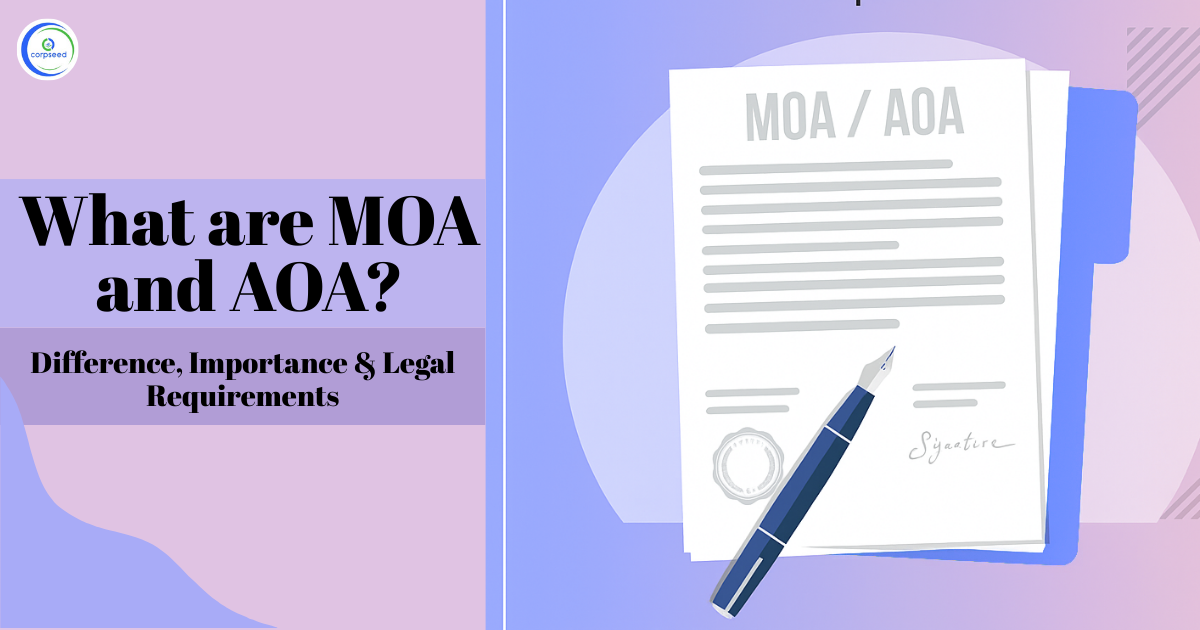Introduction: Difference Between MOA and AOA
While the memorandum of association serves as a charter that defines the firm's scope and boundaries, an article of association serves as a legal instrument that establishes corporate management standards. The Memorandum serves to describe the company's relationship with its members, as well as the rights that those members have. Let's look at the differences between an article of association and a memorandum of affiliation in this blog.
Table of Contents
- Introduction: MOA and AOA
- What does the term "Memorandum" mean?
- Clauses in the (Memorandum of Association)
- In MOA, The name (Memorandum of Association)
- MOAs of various types (Memorandum of Association)
- What is the definition of an article?
- Retrenchment Provisions
- The main differences between a Memorandum of Association (MOA) and an Articles of Association (AOA):
--------------Blog Contact Form-------------
What does the term "Memorandum" mean?
A ‘memorandum,' according to Section 2(56) of the Companies Act, 2013, refers to the original memorandum of association that a business registered or an updated one that follows the Companies Act's regulations. Let's take a closer look at the contents of the memorandum of affiliation.
Clauses in the (Memorandum of Association)
According to Section 4 of the Companies Act of 2013, a MOA must include the terms and details listed below.
- Name Clause: The name of the firm is contained in this clause, which ends with "Limited" if it is a public business and "Private Limited" if it is a private limited company.
- Situation Clause: This determines where the company's registered office and state of incorporation will be located, as well as the company's geographical limits.
- Object Clause: This clause gives an indication of the types of objects that the firm trades in, and it may be changed as the company grows and incorporates more objects.
- Liability Clause: This refers to the company's members' liability, whether limited, unrestricted, or state-owned. The unpaid sum equivalent to the shares they possess is referred to when shares limit the company's responsibility. If the company is limited by guarantee, the liability is the amount each member pledges to contribute—which could include the firm's assets if the company closes while he or she is still a member or within one year after they retire. They are responsible for paying off the company's obligations and liabilities that were incurred while they were a member. They are also in charge of the fees and charges associated with the winding-up, as well as the distribution of contributions in accordance with the rules.
- Capital Clause: It specifies the amount of capital invested, the number of shares registered, and the distribution of those shares. If the company is a one-person operation, the founder becomes a shareholder.
In MOA, The name (Memorandum of Association)
The name in the memorandum must adhere to the standards listed below.
Name should not be:
- Identical to or closely resembling the brand name of an existing company.
- The one that is now in use by another firm.
- One that is illegally offensive.
- According to the Central Government's edict, this is an unfavorable name.
- Or it may not be registered with a name that includes any word that makes it appear like it has ties to the federal government or the patronage of any state government.
- Unless they have sought clearance from the Central Government prior to registration, any word as defined in the Companies (Incorporation) Rules, 2014.
MOAs of various types (Memorandum of Association)
Depending on their format, memorandums can be of the following types.
- Table A: If a company's stock is limited,
- Table B: If the company is a limited-by-guarantee corporation
- Table C: If a firm is limited by guarantee and has a share capital.
- Table D: If the business is unrestricted
- Table E: If the corporation is unrestricted and has a share capital
What is the definition of an article?
According to Section 2(5) of the Companies Act, 2013, a "article" refers to a company's original article of association or a version that has been revised to comply with the Act's laws. The article of association is defined in Section 5 of the Companies Act, 2013 as the document that provides the company's management norms and regulations.
Retrenchment Provisions
The article contains entrenchment rules that allow only specified provisions to be changed, and these rules can be changed only by:
When a private company is founded or when all of its members agree on an amendment, it is known as a private company. When a public company is formed, it is known as a public company.
Articles of various types
- Table F: If a company's stock is limited,
- Table G: If a firm is limited by guarantee..
- Table H: If a company's guarantee and shares are limited
- Table I: If the company is unrestricted and has a share capital
- Table J: If the corporation is unrestricted and does not have a share capital
While both serve as charter documents for a corporation, an MOA (Memorandum of Association) provides the firm's basic details, whilst an AOA (Article of Association) contains the company's rules and regulations.
The main differences between a Memorandum of Association (MOA) and an Articles of Association (AOA):
The following factors are most important for determining the distinction between an article of association and a memorandum of association.
- The first distinction between MOA and AOA is that AOA (Article of Association) specifies the company's rules, while the MOA (Memorandum of Association) describes the company's powers and objectives.
- The Memorandum of Association (MOA) is subject to the Companies Act, and the Articles of Association (AOA) is subordinate to the Memorandum of Association.
- While the memorandum cannot be revised retroactively, the AOA (Article of Association) can.
- The fundamental difference between a memorandum of association and an article of association is that a memorandum has six clauses, whereas an article can be prepared according to the needs of the company.
- The MOA is required for all businesses, although a public firm can utilize Table A instead of an AOA (Article of Association).
- Changes to a MOA can only be made after getting prior approval from the Central Government and passing a Special Resolution (SR) at the Annual General Meeting, whereas changes to an AOA can only be made after passing a Special Resolution (SR) at the Annual General Meeting (AGM).
Private Limited Company Registration
Private Limited Company registration is the legal process of incorporating a company as a private limited entity under the Companies Act, 2013 in India. A Private Limited Company is a type of company that is privately held and has limited liability for its shareholders.
Proprietorship Firm Registration
Registering your proprietorship firm is essential if you want to run a successful and legally compliant business. It provides legal recognition, access to government schemes and benefits, and a competitive advantage in the market. So, if you haven't already done so, it's time to register your proprietorship firm and take your business to the next level.
Detailed Project Report
A business plan is an engraved sketch of your business's prospect, a document that describes the step to step process on what a business owner plan to do and how to execute the plan.
This portion of the site is for informational purposes only. The content is not legal advice. The statements and opinions are the expression of author, not corpseed, and have not been evaluated by corpseed for accuracy, completeness, or changes in the law.
BOOK A FREE CONSULTATION
Get help from an experienced legal adviser. Schedule your consultation at a time that works for you and it's absolutely FREE.









